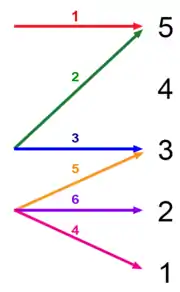Yale romanization of Cantonese
The Yale romanization of Cantonese was developed by Gerard P. Kok for his and Parker Po-fei Huang's textbook Speak Cantonese initially circulated in looseleaf form in 1952[1] but later published in 1958.[2] Unlike the Yale romanization of Mandarin, it is still widely used in books and dictionaries, especially for foreign learners of Cantonese. It shares some similarities with Hanyu Pinyin in that unvoiced, unaspirated consonants are represented by letters traditionally used in English and most other European languages to represent voiced sounds. For example, [p] is represented as b in Yale, whereas its aspirated counterpart, [pʰ] is represented as p.[3] Students attending The Chinese University of Hong Kong's New-Asia Yale-in-China Chinese Language Center are taught using Yale romanization.[4]
| Yale | |||||||||||
|---|---|---|---|---|---|---|---|---|---|---|---|
| Traditional Chinese | 耶魯 | ||||||||||
| Simplified Chinese | 耶鲁 | ||||||||||
| Cantonese Yale | Yèh-lóuh | ||||||||||
| |||||||||||
| Chinese romanization |
|---|
| Mandarin |
| Wu |
| Yue |
| Min |
| Gan |
| Hakka |
| Xiang |
| See also |
| This article is part of the series on the |
| Cantonese language |
|---|
| Yue Chinese |
| Grammar |
| Orthography |
| Phonology |
|
Initials
| b [p] 巴 |
p [pʰ] 怕 |
m [m] 媽 |
f [f] 花 |
|
| d [t] 打 |
t [tʰ] 他 |
n [n] 那 |
l [l] 啦 | |
| g [k] 家 |
k [kʰ] 卡 |
ng [ŋ] 牙 |
h [h] 蝦 |
|
| gw [kʷ] 瓜 |
kw [kʷʰ] 誇 |
w [w] 蛙 | ||
| j [ts] 渣 |
ch [tsʰ] 叉 |
s [s] 沙 |
y [j] 也 |
Finals
| a [aː] 沙 |
aai [aːi̯] 晒 |
aau [aːu̯] 筲 |
aam [aːm] 三 |
aan [aːn] 山 |
aang [aːŋ] 省 |
aap [aːp̚] 圾 |
aat [aːt̚] 殺 |
aak [aːk̚] 客 |
| ai [ɐi̯] 西 |
au [ɐu̯] 收 |
am [ɐm] 心 |
an [ɐn] 新 |
ang [ɐŋ] 生 |
ap [ɐp̚] 十 |
at [ɐt̚] 失 |
ak [ɐk̚] 塞 | |
| e [ɛː] 些 |
ei [ei̯] 四 |
eng [ɛːŋ] 聲 |
ek [ɛːk̚] 石 | |||||
| i [iː] 司 |
iu [iːu̯] 消 |
im [iːm] 閃 |
in [iːn] 先 |
ing [ɪŋ] 星 |
ip [iːp̚] 攝 |
it [iːt̚] 舌 |
ik [ɪk] 色 | |
| o [ɔː] 蔬 |
oi [ɔːy̯] 鰓 |
ou [ou̯] 酥 |
on [ɔːn] 看 |
ong [ɔːŋ] 康 |
ot [ɔːt̚] 割 |
ok [ɔːk̚] 各 | ||
| u [uː] 夫 |
ui [uːy̯] 灰 |
un [uːn] 寬 |
ung [ʊŋ] 風 |
ut [uːt̚] 闊 |
uk [ʊk] 福 | |||
| eu [œː] 靴 |
eui [ɵy̯] 去 |
eun [ɵn] 信 |
eung [œːŋ] 上 |
eut [ɵt̚] 摔 |
euk [œːk̚] 削 | |||
| yu [yː] 書 |
yun [yːn] 孫 |
yut [yːt̚] 雪 |
||||||
| m [m̩] 唔 |
ng [ŋ̩] 吳 |
- Only the finals m and ng can be used as standalone nasal syllables.
Tones

Modern Cantonese has up to seven phonemic tones. Cantonese Yale represents these tones using a combination of diacritics and the letter h.[5][6] Traditional Chinese linguistics treats the tones in syllables ending with a stop consonant as separate "entering tones". Cantonese Yale follows modern linguistic conventions in treating these the same as the high-flat, mid-flat and low-flat tones, respectively.
| No. | Description | IPA & Chao tone numbers |
Yale representation | ||
|---|---|---|---|---|---|
| 1 | high-flat | ˥ 55 | sī | sīn | sīk |
| high-falling | ˥˨ 52 | sì | sìn | ||
| 2 | mid-rising | ˨˥ 25 | sí | sín | |
| 3 | mid-flat | ˧ 33 | si | sin | sik |
| 4 | low-falling | ˨˩ 21 | sìh | sìhn | |
| 5 | low-rising | ˨˧ 23 | síh | síhn | |
| 6 | low-flat | ˨ 22 | sih | sihn | sihk |
Examples
| Traditional | Simplified | Romanization |
|---|---|---|
| 廣州話 | 广州话 | Gwóngjàuwá |
| 粵語 | 粤语 | Yuhtyúh |
| 你好 | Néih hóu | |
Sample transcription of one of the 300 Tang Poems by Meng Haoran:
| 春曉 孟浩然 | Chēun híu Maahng Houh-yìhn |
|---|---|
| 春眠不覺曉, | Chēun mìhn bāt gok híu, |
| 處處聞啼鳥。 | chyu chyu màhn tàih níuh. |
| 夜來風雨聲, | yeh lòih fūng yúh sīng, |
| 花落知多少? | fā lohk jī dō síu? |
See also
References
- Huang, Parker Po-fei (1965). Cantonese Sounds and Tones. New Haven, CT: Far Eastern Publications, Yale University. p. Foreword.
- The Routledge Encyclopedia of the Chinese Language, p. 40.
- "Cantonese". Omniglot. Retrieved 2016-10-27.
- "CUHK Teaching Materials". Retrieved 2016-10-27.
- Ng Lam & Chik 2000: 515. "Appendix 3: Tones. The student of Cantonese will be well aware of the importance of tones in conveying meaning. Basically, there are seven tones which, in the Yale system, are represented by the use of diacritics and by the insertion of h for ..."
- Gwaan 2000: 7. "Basically, there are seven tones which, in the Yale system, are represented by the use of diacritics and by the insertion of h for the three low tones. The following chart will illustrate the seven tones: 3 Mid Level, 1 High Level, 5 Low Falling, 6 Low Level..."
Further reading
- Gwaan, Choi-wa 關彩華 (2000). English-Cantonese Dictionary - 英粤字典: Cantonese in Yale Romanization (2nd ed.). Chinese University Press. ISBN 962-201-970-6.
- Matthews, Stephen & Yip, Virginia (1994). Cantonese. A Comprehensive Grammar. Routledge. ISBN 0-415-08945-X.
- Ng Lam, Sim-yuk & Chik, Hon-man (2000). Chinese-English Dictionary 漢英小字典: Cantonese in Yale Romanization, Mandarin in Pinyin. Chinese University Press. ISBN 962-201-922-6.